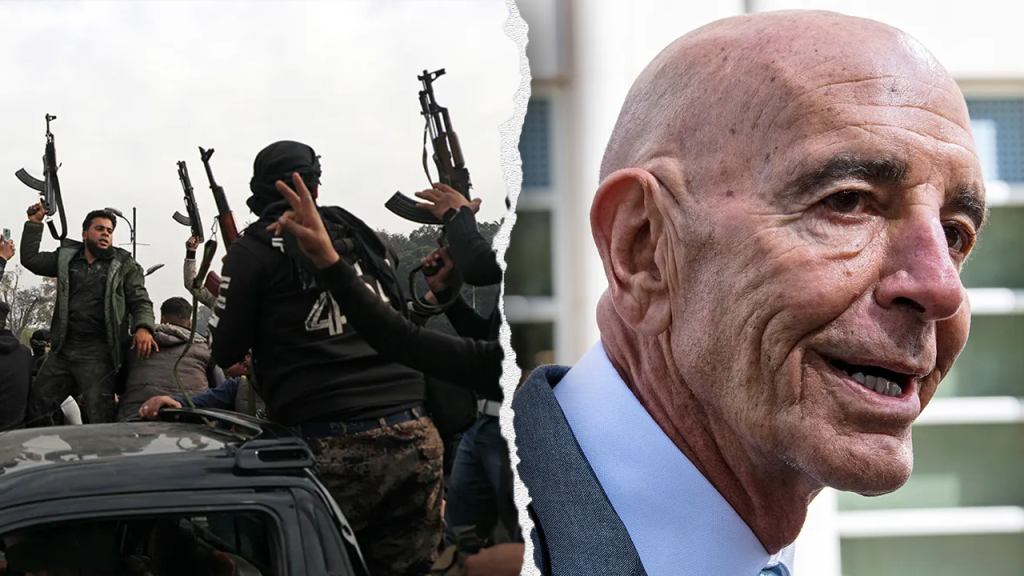On Friday, Tom Barrack, U.S. Ambassador to Turkey and former advisor to President Donald Trump, announced his new role as the U.S. Special Envoy for Syria. This appointment comes in the context of lifting longstanding sanctions against the Syrian government to help stabilize the war-torn country. Barrack’s task aims to align with the Trump administration’s vision for a more prosperous Middle East, focusing on the importance of defeating ISIS and fostering peace in Syria.
| Article Subheadings |
|---|
| 1) New Appointment for Tom Barrack |
| 2) Lifting Sanctions: A New Strategy |
| 3) The Role of the U.S. Military in Syria |
| 4) Regional Collaboration for Peace |
| 5) Implications for U.S. Foreign Policy |
New Appointment for Tom Barrack
In an official announcement on May 14, Tom Barrack, a longstanding ally of former President Trump, disclosed that he will serve as the U.S. Special Envoy for Syria. This role involves directly supporting Marco Rubio, the current Secretary of State, to implement the President’s vision for a stabilized Syria. Barrack indicated that his new position will involve close collaboration with various stakeholders, including international partners and regional allies.
Barrack’s new role places him in the thick of ongoing geopolitical challenges in Syria, where the ongoing civil war has created a complex landscape. His history as Ambassador to Turkey could also be beneficial in navigating the web of alliances and enmities in the region.
Lifting Sanctions: A New Strategy
On May 13, President Trump announced that the U.S. will lift its long-standing sanctions against Syria, a move aimed at facilitating the stabilization of the war-torn country. Initially imposed in 1979, these sanctions were a response to Syria being labeled as a state sponsor of terrorism. The lifting comes as part of a broader strategy to allow the new Syrian government to regain control and authority following significant upheaval.
Barrack stated that the cessation of these sanctions would help preserve the core objective of defeating ISIS and provide a pathway for the Syrian populace to recover. This decision reflects a shift in U.S. foreign policy, moving from isolation to engagement, as officials assess the post-Assad landscape.
The Role of the U.S. Military in Syria
The U.S. maintains a military presence in Syria, with around 1,500 troops deployed to combat ISIS. These forces work alongside about 10,000 ISIS fighters held by the Syrian Democratic Forces, a U.S.-backed coalition primarily composed of Kurdish groups. The U.S. military’s cautious yet strategic involvement underscores the complexity of the situation in Syria, where various factions vie for power in a fractured political environment.
As Barrack steps into his new role, the U.S. military’s objectives are likely to remain focused on counterterrorism efforts, while also adapting to the new diplomatic initiatives. This dual approach may help to stabilize not only Syria but also the broader region.
Regional Collaboration for Peace
In his statement, Barrack emphasized the importance of collaborative efforts with regional partners, especially Turkey and Gulf states, to restore hope and security in Syria. The restoration of diplomatic relations, particularly with Turkey, is crucial given its historical and geographic proximity to Syria and its influence on various factions within the country.
As the U.S. pivots its policy approach, engaging regional stakeholders will be pivotal in ensuring a coordinated strategy aimed at societal recovery in Syria and a proactive stance against potential terrorist threats from groups like ISIS.
Implications for U.S. Foreign Policy
This shift in U.S. policy towards Syria has broad implications for American foreign relations in the Middle East. Many observers note that this could mark a historic pivot in how the U.S. engages with formerly adversarial regimes. Barrack’s leadership aims to align U.S. actions more closely with its stated goals of achieving stability in the region.
As international observers watch, the U.S. faces the challenge of balancing national security interests with humanitarian concerns, particularly as the Syrian people seek an end to years of conflict and suffering.
| No. | Key Points |
|---|---|
| 1 | Tom Barrack appointed U.S. Special Envoy for Syria to support stabilization efforts. |
| 2 | President Trump to lift sanctions against Syria to facilitate governmental recovery. |
| 3 | U.S. military presence remains critical in combating ISIS and supporting local forces. |
| 4 | Regional partnerships with Turkey and Gulf states emphasized for restoring peace. |
| 5 | The shift signals a potential reorientation of U.S. foreign policy in the Middle East. |
Summary
The appointment of Tom Barrack as U.S. Special Envoy for Syria marks a significant shift in American foreign policy towards the region, particularly through the lifting of longstanding sanctions aimed at stabilizing the country. Through Barrack’s leadership, the administration seeks to align military objectives with diplomatic engagement, emphasizing regional collaboration for a more peaceful future in Syria. This realignment aims not only to address immediate security concerns but also to offer hope for a lasting resolution to the humanitarian crisis impacting millions in the region.
Frequently Asked Questions
Question: What is the role of the U.S. Special Envoy for Syria?
The U.S. Special Envoy for Syria is tasked with facilitating diplomatic initiatives and strategies aimed at stabilizing Syria post-conflict, particularly through engagement with local and regional partners.
Question: Why were sanctions imposed on Syria?
Sanctions were first imposed on Syria in 1979 due to its designation as a state sponsor of terrorism. The aim was to apply pressure on the Syrian government to change its behavior concerning regional conflict and terrorism.
Question: How many U.S. troops are currently stationed in Syria?
Approximately 1,500 U.S. military personnel are stationed in Syria as part of coalition efforts to combat ISIS and support local forces, particularly the Syrian Democratic Forces.
